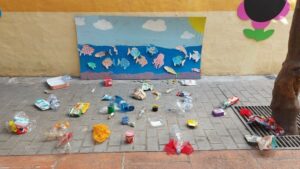BeMed 3. Our Sea
Title |
Our Sea |
Author |
Amanda Pace, Mariella Grech & Melissa Grima |
Age Guide |
KG2 |
Subject Area |
Music, ICT, Arts & Crafts, Numeracy Skills (Sorting), Knowledge & Understanding of the World |
| Preparation Time | Approximately 2 hours (over a period of 2 days in which during this time the students paint the scene and the frame using paint, enhancing interaction and socialisation and colour a Picture of a fish with crayons.) |
| Estimated Duration | 60 minutes + a day outing |
| Site | School & a preferred sandy beach |
| Educational objectives | The aim of this activity is to raise awareness and enhance our students’ knowledge – from an early age – of the beauty of our environment, particularly marine life, what we can do to keep it clean (especially from plastic). During this activity, students will enrich their learning through multisensory approaches, increase their listening and communication skills as well as develop socially. |
| Learning Outcomes | Children who have a positive self-image.
– I am able to ask questions in order to learn new things.Children who develop positive attitudes which enable them to take the initiative and become risk- takers. – I am motivated to engage with a range of learning opportunities present in my environment. Children are socially adept. Children who learn to collaborate with peers and adults. Children who are effective communicators. Children who are versatile and skilled with knowledge and information as well as meaning making and comprehension. – I sort objects into simple categories. |
| Link to SDGs | SDG 14: Life Below Water |
| Educational resources required | Sea Animals Colouring Pages (colouring book style pictures of a crab, jelly fish, seaweed, fish, turtle, etc. especially those found locally) such as can be found here: https://www.firstpalette.com/printable/sea-animals.html , https://www.pngwing.com/en/free-png-nwnxw, https://www.vecteezy.com/vector-art/127843-free-sea-creatures-vectors
Video clips on You Tube: A whale’s tale: https://www.youtube.com/watch?v=ZgLa7bPB6DA Animals in the Ocean Action Song: https://www.youtube.com/watch?v=gGz176Oz4TY Save the Sea Animals: https://www.youtube.com/watch?v=ogtvFbBfPEA Sea Life Frame and Scene (as in photos): paint, large cardboard box, glue, googly eyes, recycled foam, scissors and wall nut shells. Trash Items for Recycling Trash Game Internet connection |
| Remote preparation | Learners are asked about the sea creatures and how we should take care of them when they have to draw them in preparation for this activity. The teacher will also explain what she intends to carry out when painting the scene, the frame and the sea creatures so that they know the reason why they are going to take part in this activity that is: to save our seas.
|
| Planning Considerations | Student misconceptions: Learners may think that ALL sea creatures are being killed because of plastic pollution, however the teacher must explain that we should learn how to reduce plastic waste and recycle it so that we protect sea life from further harm.
Safety Precautions: During the sorting activity the teacher must be very careful so that children would not hurt themselves with any sharp materials or glass that they can break easily. Tips: When painting the scene, it is best if it is done in the yard so that children have enough space where to stay around the cardboard so that they can help each other.
|
| Method | Introduction
The activity will be introduced with the story on a You Tube video named: A whale’s tale. Children are given time to watch it and afterwards they are asked several open-ended questions to check for understanding and whether they know what to do in order to start conserving and sustainably use the sea. Examples of the open-ended questions asked: What can you see in the video? What happened to the whale? What could be the issue that the whale had in the ocean? What can we do to avoid the sea creatures from dying? Learners are also encouraged to dance with the action song named Animals in the Ocean Action Song (link in the educational resources) so that they will imagine themselves in the sea like the sea creatures. Development As a development of the activity, learners are going to carry out a hands-on multi-sensory activity by creating a sea turtle with the use of natural objects such as
Give several turns to all learners until all the trash is sorted in the right bins and all of the ‘sandy beach’ is clean. Explain to the learners that they should always keep the beach clean like they did in the sorting activity as otherwise it would end up in the sea. Conclusion Extension of this Activity: Outing – Clean Up the Beach and sorting the trash in the correct bin (on the beach). To conclude the activity the teacher should take the opportunity to take a photo of all the learners with the frame created prior to the activity to create awareness to save our seas, while also singing to a song named: Save the Sea Animals (link in the Educational Resources). The song should be repeated more than once so that children are encouraged to sing along.
|
| Follow-up activities | During Outing – Cleanup of beach |
| Background information for educators | Useful Links related to saving our ocean:
10 things you can do to save the ocean – https://www.nationalgeographic.com/environment/article/10-things-you-can-do-to-save-the-ocean Saving Earth One Craft at a time – https://oceanconservancy.org/blog/2018/04/20/saving-earth-one-craft-time/ |
| Adaptations | Learners with difficulties should be helped so that they will be able to carry out the sea turtle craft and also take part in the sorting activity of trash. |
| Extensions | On the other hand, for gifted students, teacher should challenge them by asking them questions which require more thinking and reasoning skills – thinking outside the box. |
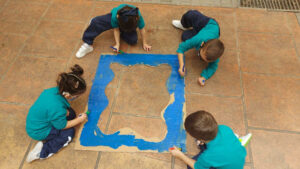
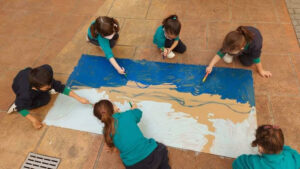
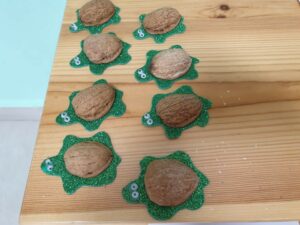 walnut’s shell. First, the children need to draw the turtle template, then glue the shell and put on two googly eyes to represent the turtle’s eyes. These sea turtles can also be glued to the scene and the frame in order to add more sea animals to them while also adding different textures. In order to create the scene and the frame, educators and learners will recycle a huge cardboard box and learners have to paint it using the blue paint for sea and sky, white for clouds and yellow paint for the sun. Children will then colour the sea creatures using crayons and decorate them. Educators will then cut around the sea creatures and stick them either on the scene or the frame. Afterwards, the learners are going to participate in a Recycling Sorting Activity but it is best if they go out in the yard to have more space (if the weather permits).
walnut’s shell. First, the children need to draw the turtle template, then glue the shell and put on two googly eyes to represent the turtle’s eyes. These sea turtles can also be glued to the scene and the frame in order to add more sea animals to them while also adding different textures. In order to create the scene and the frame, educators and learners will recycle a huge cardboard box and learners have to paint it using the blue paint for sea and sky, white for clouds and yellow paint for the sun. Children will then colour the sea creatures using crayons and decorate them. Educators will then cut around the sea creatures and stick them either on the scene or the frame. Afterwards, the learners are going to participate in a Recycling Sorting Activity but it is best if they go out in the yard to have more space (if the weather permits).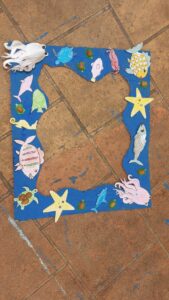 The teacher should explain to the learners how we sort our trash in different bins so that they can be recycled and by also giving them an example or two so that they won’t get confused what they should do when it is their turn to sort out the trash.
The teacher should explain to the learners how we sort our trash in different bins so that they can be recycled and by also giving them an example or two so that they won’t get confused what they should do when it is their turn to sort out the trash.